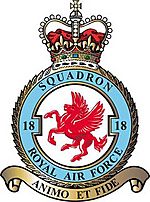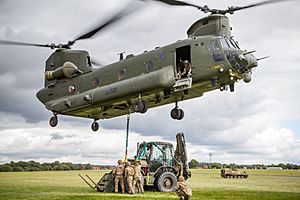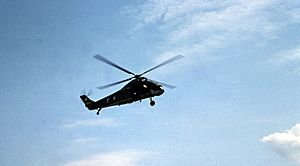No. 18 Squadron RAF facts for kids
Quick facts for kids No. 18 Squadron RAF |
|
|---|---|

Squadron badge
|
|
| Active | 11 May 1915 – present |
| Country | |
| Branch | |
| Type | Flying squadron |
| Role | Helicopter heavy-lift support |
| Part of | Joint Helicopter Command |
| Home station | RAF Odiham |
| Nickname(s) | Burma |
| Motto(s) | Animo et fide (Latin for 'With courage and faith') |
| Aircraft | Boeing Chinook |
| Battle honours |
|
| Insignia | |
| Squadron badge heraldry | Pegasus rampant, commemorating the squadron's co-operation with the Cavalry Corps on the Somme during the First World War. Approved by King Edward VIII in May 1936. |
No. 18 Squadron is a special part of the Royal Air Force (RAF). It flies the powerful Boeing Chinook helicopters. Their home base is RAF Odiham in the UK.
Because of its history as a bomber squadron, it is also known as No. 18 (B) Squadron.
Contents
History of No. 18 Squadron
First World War Service (1915-1919)
No. 18 Squadron started on May 11, 1915, at RAF Northolt. It was part of the Royal Flying Corps. In November 1915, the squadron moved to France. They used planes like the Vickers FB5 'Gunbus' and Airco DH.2s. Their main job was to help the army on the ground.
By April 1916, they flew FE2bs. These planes were used a lot during the Battle of the Somme. They even trained to help the cavalry if they broke through enemy lines. Later in 1916, they started flying at night because their planes were safer then.
From June 1917, the squadron began using Airco DH.4s. These planes were good for long-range attacks. In March 1918, the Germans launched a big attack called Operation Michael. No. 18 Squadron helped stop these attacks. They flew low to the ground and also at medium height.
When the fighting moved north to the Battle of the Lys, the squadron was very busy. On April 12, their pilots flew for 44 hours, making six attacks near Merville. In September 1918, they started using Airco DH.9As. By the end of the war, they had won 200 air battles.
After the war ended in November 1918, the squadron moved to Germany. They helped the British Army by carrying mail. In September 1919, they returned to Britain. The squadron was officially closed on December 31, 1919.
Reforming and New Roles (1931-1963)
No. 18 Squadron started again on October 20, 1931, at RAF Upper Heyford. They flew Hawker Hart light bombers. They practiced their bombing skills and took part in air shows. They were also part of a special review for King George V in 1935.
In 1936, they moved to RAF Bircham Newton. Some of their planes and pilots left to form No. 49 Squadron. Later that year, their Hawker Harts were replaced by better Hawker Hind planes. In May 1939, they got new Bristol Blenheim I bombers.
Second World War Missions (1939-1946)
When Second World War began, No. 18 Squadron was in France. They flew reconnaissance missions, which means they looked for enemy movements. In February 1940, they got improved Blenheim IVs. When Germany invaded France, the squadron also bombed German troops.
They had to move airfields quickly. On May 19, they were ordered back to England. The squadron then started attacking enemy ships. In August 1941, one of their planes dropped a special package over France. It was a spare artificial leg for Wing Commander Douglas Bader, a famous pilot.
Later, the squadron moved to North Africa. They flew bombing missions during the day. In December 1942, Wing Commander Hugh Malcolm led a brave raid. His plane was shot down, and he was given the Victoria Cross medal after his death. From 1943 to 1945, No. 18 Squadron helped the Allies in Italy. They then moved to Greece in September 1945 and were closed down on March 31, 1946.
Post-War Operations (1953-1980)
The squadron was reformed in 1953 at RAF Scampton. They flew Canberra B.2 bombers. However, they were closed again on February 1, 1957.
On December 15, 1958, No. 18 Squadron was reformed again. This time, they flew Vickers Valiant planes. These planes were used for electronic countermeasures (ECM). This means they could block enemy communications and radar. They helped train other pilots and supported bomber planes. The squadron was closed again on March 31, 1963.
In 1964, the squadron started flying again. They used Westland Wessex HC.2 helicopters at RAF Odiham. In August 1970, they moved to RAF Gütersloh in Germany. They supported the British Army there. This period ended when the squadron was closed on November 20, 1980.
Chinook Era and Modern Missions (1981-Present)
No. 18 Squadron was reformed on August 4, 1981. This time, they began flying Chinook HC.1 helicopters. These large helicopters are still used by the squadron today.
Falklands War (1982)
In 1982, No. 18 Squadron took part in the Falklands War. Four of their Chinooks were sent south. Sadly, three were lost when the ship carrying them, the Atlantic Conveyor, was hit by a missile. The one remaining Chinook, named Bravo November (ZA718), flew almost non-stop. It helped a lot until the end of the conflict. Squadron Leader Richard "Dick" Langworthy was given the Distinguished Flying Cross (DFC) for his brave flying. In August 1983, the squadron returned to Germany.
Recent Operations
No. 18 Squadron also helped in the Gulf War in 1991. After this, the squadron moved from Germany to RAF Laarbruch in December 1992. As the British presence in Germany was reduced, No. 18 Squadron moved back to RAF Odiham in August 1997.
Their Chinook HC.2 helicopters were sent to Iraq for Operation Telic. In 2017, the squadron helped with Operation Ruman. This was a UK effort to help the Caribbean after Hurricane Irma. In 2018, their Chinook Mk5s formed part of 1310 Flight. This flight went to Mali to support a French anti-terrorist operation.
In March 2020, the squadron was honored for its role in the War in Afghanistan (2001-2014). They were given the right to display a special battle honour on their squadron standard.
See also
- List of Royal Air Force aircraft squadrons




